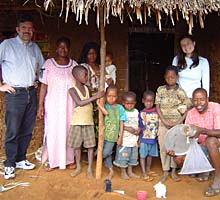Smith
Biologist Leads Effort to Wipe Out Parasite

Steve Williams (far left) with former researcher Lea
Ochhialini (right, standing) in a village in Tanzania
stricken with filariasis. |
With Smith biologist Steven A. Williams on sabbatical, his
office in the Science Center has been turned into storage
space for cardboard boxes packed with blood, mosquito and
urine tests, awaiting shipment to distant locales.
The cartons are earmarked
for tropical regions in Africa, Asia, Latin America and
the South Pacific, where mosquitoes quietly and consistently
spread a certain parasitic worm from human to human – infecting
more than 150 million people and placing at risk more than
a billion.
Williams, the Gates Professor
of Biological Sciences, along with a group of researchers
from a smattering of the nation’s
leading research institutions, recently published a significant
discovery in the effort to eliminate that parasitic worm:
the complete sequence of its genetic code.
Now the work can begin to develop a vaccine and new drugs
to wipe out the filarial parasite and, by extension, the
debilitating diseases it causes.
But just getting to this
point was a significant undertaking. Solving the worms’ genetic code eventually involved
71 researchers – 12 of whom have connections to Smith – whose
names appear at the top of their paper in the Sept. 21 issue
of the prestigious journal Science.
That was a far cry from
the project’s modest beginning
in Williams’ lab, where he coordinated the genome effort
for the World Health Organization from its inception in 1994
to its completion in 2005, and where the actual work to decipher
the genetic code began.
The researchers in Williams’ lab had read 100 million
nucleotides of the worm’s genetic code by the time
the project received a funding infusion from the National
Institutes of Health in 2003 and the work shifted to a larger
research facility that sped up the process of reading the
remaining 750 million.
“Parasites are difficult to study because they live
inside another organism,” said Williams. “The
only realistic approach was to study the DNA and get at it
at the molecular level.”

An 18-year-old woman from Tanzania with severe elephantiasis
in both legs. |
Any new drugs or vaccines
that result from the knowledge of the worms’ genetic
code would be welcome news to the victims of the disease
elephantiasis, whose current drug options only target the
larvae and do not completely kill adult worms, which can
live up to eight years in the human body.
Its elimination would
also be welcome news to the World Health Organization,
which established that as a goal at the beginning of this
decade – an ambitious idea considering
that scientists have only been able to rid mankind of one
disease throughout history: Smallpox.
And, developing new vaccines and drugs may not be all that
is necessary to reach that goal.
Recognizing that, Williams
is now helping coordinate
a $14 million project involving five other principal investigators
and funded by the Bill and Melinda Gates Foundation, which
aims to pinpoint the potential weaknesses in that plan and
identify ways to circumvent them. He is currently doing the
work in an office at the Lymphatic Filariasis Support Center,
Task Force for Child Survival and Development, in Atlanta.
One potential weakness Williams and the other researchers
working with him have identified is the ability to track
the worm and the diseases it causes as it spreads from person
to person by mosquitoes.
“To eliminate lymphatic filarial disease we need the
ability to track the disease and that means identifying people
with low levels of infection,” he said.
Victims of infection often do not realize they are sick
until they begin to be disfigured, their limbs expanding
to painful proportions by elephantiasis. So, to identify
people who have the parasite before symptoms occur, Williams
developed a simple blood test.
And, as the cartons of
blood tests in Williams’ office
are shipped to places around the world, he will continue
working toward the goal that the WHO established.
As Williams recently noted,
now that the genetic code has been solved, "we can
find the Achilles heel of the parasite and eliminate it."
|























